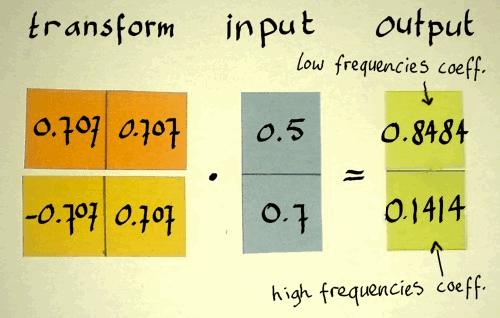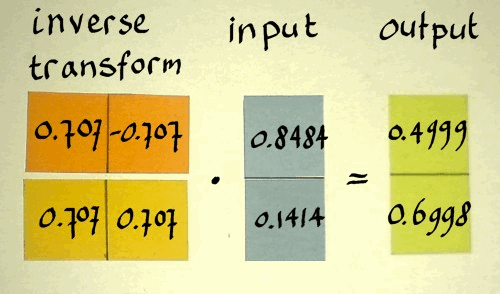
The page on inner product showed how vectors can be perpendicular,
even when they have too many dimensions to draw them in a plane. When
two vectors have inner product zero, they are perpendicular, or
orthogonal as it is called. Orthogonal vectors are indispensable when
transforming data between domains of signal processing. If you
transform a time-domain signal to the frequency domain, you might want
to alter some frequency-information and then go back to time domain.
Apart from the deliberate alterations,
you want a faithful resynthesis of the original signal. Therefore the
transform matrices must cover the complete space, with vectors that do
not overlap.
I want to illustrate a transform and it's inverse with the simplest
possible example. I will abuse the 2x2 matrix of a complex
multiplication because we know that is has an orthogonal matrix. But
now I suggest the input is two samples of a real signal, instead of a
complex
number.
 |
The output is (-0.26, 0.82). Now from this I want to retrieve my
input signal. What does the inverse transform look like? In this case,
it is the
so-called transpose of the transform matrix: the entries are mirrored
over the main diagonal. The 0.8 and -0.8 are exchanged,
and there we have the transpose. With this matrix we will get the
original input back.
 |
It is perfect, and I did not round anything. What type of transform
was that, by the way? It was a kind of
fantasy 2-point Discrete Fourier Transform with rotated spectrum.
Nothing very useful in practice. The reason I chose 0.6 and 0.8 in the
example is that they form a precise unit vector. Therefore, the matrix
is not only orthogonal, but also orthonormal. Without a unit vector,
the example would not have worked so relaxed as it did!
Why not? If vectors with a norm other than 1 are in the transform
matrix, the energy in the processed signal is altered. That should at
least be compensated for the inverse transform, otherwise you would end
up with a signal of different magnitude. Such compensation is not
difficult. It is just a matter of scaling the transpose matrix.
Let us swiftly do an example of that.
 |
This transform matrix has vectors with norm other than 1:
 |
To normalise the vectors, you would divide them by the norm, so
divide the components by the square root of two. But if you do not
normalise here, you can 'norma-normalise' the matrix for the inverse
transform. Then you
need to divide by the norm*norm:
 |
We will do that here. Not forget to transpose the matrix. As you can
see from the result, this method will reconstruct the original signal
samples just as well.
 |
My conclusion is: orthogonality is a must for a faithful
reconstruction, but regarding normalisation there is slightly more
freedom. If you want to preserve energy in the transformed data, the
transform matrix should be orthonormal. But there can be reasons for
choosing another normalisation type. If only you do not forget to
compensate in the inverse.
Summarizing, we have done two fantasy transforms until now, with
rotated spectrum and a non-representative energy-content. Why not just
demonstrate a more realistic Fourier Transform? Hmmmm... we need more
decimals to approach that. Let me use three decimals to represent the
square root of two: 1.414. And it's inverse, 0.707. In addition, I will
choose the transform vectors in such a way that the first one
correlates on low frequencies and the second (alternating) one on high
frequencies.
 |
And below is it's transpose. From the result it is clear that the
signal's energy content is slightly reduced. That is because I rounded
the square root of two, and the vectors became slightly smaller than a
unit vector. With more precision in the transform vectors, the result
could also be more precise. That would be a gradual difference and not
a decisive difference, because very few numbers on the unit circle can
be expressed with finite precision. In fact, one of these few was used
in the first example.
 |
Although a 2 point DFT is of no practical use because of it's poor
frequency resolution, such simplistic cases can clarify important
aspects. The examples showed that a transform with the poorest possible
resolution may still be capable of doing an excellent reconstruction.
If only the vectors are orthogonal and well-normalised. The
frequency-responses of such vectors will overlap dramatically, and that
may be a good reason to use longer arrays in a transform matrix. But a
dramatic overlap in the responses do not prohibit a good
reconstruction. Therefore, the choice of resolution does not relate to
demands on reconstructibility. However, developing orthogonal matrices
can be a challenge of it's own kind...